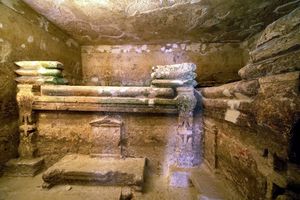FUNERARY ART IN THE EASTERN MEDITERRANEAN (4TH C. - 1ST C. BCE)
Old Connections and New Beginnings
A new project, under the general title: "Funerary art in the Eastern Mediterranean (4th c. - 1st c. BCE): old connections and new beginnings" (March 2024 - February 2027), designed as an international program of academic research, exchange, and collaboration devoted to the study of Hellenistic burial practices and their intellectual imprint.
The Program is funded by the Getty Foundation as part of the Connecting Art Histories initiative.
Hellenistic culture flourished across the Eastern Mediterranean basin from the 4th to the 1st c. BCE, and produced innovative, long-lived, and deeply influential forms of art, in architecture, painting, and sculpture, as well as the minor arts. Burial practices in particular, widely re-invented in the beginning of the period, betray fundamental changes in society, religion, and cult.
Divided between multiple nation-states in our times, the area that once formed – loosely or not – what we still understand as the “Hellenistic East” created and bequeathed to the modern world significant artforms which are yet to be fully studied. Once dominated by Western scholars and centers of learning, the study of funerary art in the Eastern Mediterranean has now more or less been passed to universities, research centers, and state archaeological services based on the host countries themselves, still in active collaboration with the old leaders in the West.
Since the end of Antiquity, and all the way to the Modern Era, the different cultures active in the Eastern Mediterranean have continued to re-invent and commemorate themselves through mortuary habits and the funerary art that was used to frame them. These often borrow from the area’s multi-faceted past, or import artforms from western cultural centers. Today, funerary art from the 18th and the 19th c., continues to grace cemeteries across the Eastern Mediterranean, turning its cities into memoryscapes dedicated to its cultures and its peoples. Feeding off a shared Greek / Macedonian / Egyptian heritage, enhanced by tradition, folklore, archaeology, and – not least – 20th c. pop culture, Ptolemaic culture and art remains in the 21st c. an important component of a common Mediterranean identity, as well as cultural ancestry, in and out of Academia.

Support for this Program is provided by the Getty Foundation as part of its Connecting Art Histories initiative.

